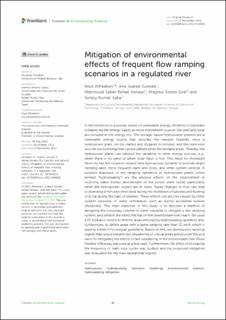| dc.contributor.author | Alfredsen, Knut | |
| dc.contributor.author | Juarez Gomez, Ana | |
| dc.contributor.author | Kenawi, Mahmoud Saber | |
| dc.contributor.author | Graf, Magnus | |
| dc.contributor.author | Saha, Sanjoy Kumar | |
| dc.date.accessioned | 2022-11-21T09:26:52Z | |
| dc.date.available | 2022-11-21T09:26:52Z | |
| dc.date.created | 2022-11-17T07:55:37Z | |
| dc.date.issued | 2022 | |
| dc.identifier.citation | Frontiers in Environmental Science. 2022, 10 . | en_US |
| dc.identifier.issn | 2296-665X | |
| dc.identifier.uri | https://hdl.handle.net/11250/3033072 | |
| dc.description.abstract | In the transition to a society based on renewable energy, flexibility is important in balancing the energy supply as more intermittent sources like wind and solar are included in the energy mix. The storage-based hydropower systems are a renewable energy source that provides the needed flexibility since a hydropower plant can be started and stopped in minutes, and the reservoirs provide stored energy that can be utilized when the demand arises. Thereby, the hydropower plants can balance the variability in other energy sources, e.g., when there is no wind or when solar input is low. This need for increased flexibility has led research toward new hydropower turbines to provide larger ramping rates, more frequent starts and stops, and other system services. A possible drawback of the ramping operation of hydropower plants (often termed “hydropeaking”) are the adverse effects on the environment in receiving water bodies downstream of the power plant outlet, particularly when the hydropower outlets are in rivers. Rapid changes in flow can lead to stranding of fish and other biota during the shutdown of turbines and flushing of biota during the start of turbines. These effects can also be caused by other sudden episodes of water withdrawal, such as during accidental turbine shutdowns. The main objective of this study is to describe a method of designing the necessary volume of water required to mitigate a fast ramping turbine, and present the effect this has on the downstream river reach. We used a 2D hydraulic model to find the areas affected by hydropeaking operation and, furthermore, to define areas with a faster ramping rate than 13 cm/h which is used as a limit in Norwegian guidelines. Based on this, we developed a ramping regime that would prevent fast dewatering of critical areas and provide this as a basis for mitigating the effects of fast dewatering in the downstream river (River Nidelva in Norway was used as a test case). Furthermore, the effect of increasing the frequency of start–stop cycles was studied, and the proposed mitigation was evaluated for the new operational regime | en_US |
| dc.language.iso | eng | en_US |
| dc.publisher | Frontiers Media | en_US |
| dc.rights | Navngivelse 4.0 Internasjonal | * |
| dc.rights.uri | http://creativecommons.org/licenses/by/4.0/deed.no | * |
| dc.title | Mitigation of environmental effects of frequent flow ramping scenarios in a regulated river | en_US |
| dc.title.alternative | Mitigation of environmental effects of frequent flow ramping scenarios in a regulated river | en_US |
| dc.type | Peer reviewed | en_US |
| dc.type | Journal article | en_US |
| dc.description.version | publishedVersion | en_US |
| dc.source.pagenumber | 13 | en_US |
| dc.source.volume | 10 | en_US |
| dc.source.journal | Frontiers in Environmental Science | en_US |
| dc.identifier.doi | 10.3389/fenvs.2022.944033 | |
| dc.identifier.cristin | 2075239 | |
| dc.relation.project | EC/H2020/764011 | en_US |
| cristin.ispublished | true | |
| cristin.fulltext | original | |
| cristin.qualitycode | 1 | |

